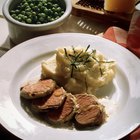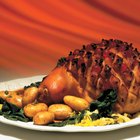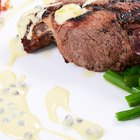
donstock/iStock/Getty Images
Typically, roasting is used to make tougher, higher-fat and less expensive cuts of meat tender and flavorful. However, with some careful preparation, a lean cut of meat can make a successful roast. Lean roasts are less flavorful than their fattier counterparts, so they tend to need extra seasoning. Because their connective tissue breaks down more easily, lean roasts require less cooking time, a higher cooking temperature and little or no moisture. For a lean pork roast option, try a center loin cut. For lean beef, use a tenderloin or ribeye roast.
Preheat the oven to 450 degrees Fahrenheit, and then create your rub. Blend the pepper, salt, sugar, spices and oil in a small mixing bowl. If you're making a beef roast, chop the garlic cloves finely or put them through a garlic press, and add them to the rub. For a pork roast, cut the cloves into slices or wedges and set them aside.
Trim any visible fat from the roast. With a small paring knife, pierce holes in the roast in various places, turning the knife back and forth to create small, wide "pockets." Rub the seasoning mixture all over the roast. For a beef roast, pack some of the rub into the pockets. For a pork roast, tuck a garlic wedge or slice into each pocket.
Place the rack in the roasting pan, and place the meat on the rack. You can use a plain roasting pan instead of a rack, but don't add liquid. Place the pan in the oven, and cook the roast for 10 minutes at 450 degrees F. This will sear the outside of the roast and form a flavorful crust.
Lower the temperature to 350 degrees F for beef or 325 degrees for pork. For beef, cook the roast an additional 25 to 30 minutes for medium rare -- or until the internal temperature reaches 140 degrees. Pork roasts require a longer cook time -- about 20 to 25 minutes per pound after searing, or until the internal temperature reaches at least 160 degrees.
Allow the meat to rest for 20 minutes. This allows the juices to redistribute, which means they won't run out of the meat when you slice it.
Related Articles

How to Make quick Meat Loaf

How to Roast Italian Sausage

How to Cook the Neck of a Deer

How to Roast an Eye Round Roast at High ...

How to Make a Juicy Pork Tenderloin

How to Cook a Four-Pound Sirloin Tip ...

How to Cook a Beef-Pork Combo Roast

How to Use a Square Knot for Dress or ...

How Do I Cook Boneless Pork Leg Roast ...

How to Bake a Pork Loin Center Half

How to Make a Black Pepper Crust on a ...

How Long Does It Take to Cook a ...

How to Cook a 15-Pound Rib Roast

How to Cook Venison Chop on a Grill

How to Grill Boneless Chicken Strips

How to Cook Tender Rolled Flank Steaks ...
How to Cook a Center Cut Sirloin of ...
How to Smoke Venison Neck Roast

How to Cook a Choice New York Roast

How to Cook a Ribeye Roast With Veggies ...
References
Writer Bio
Jessica Martinez is a freelance writer from Clayton, North Carolina. As a homeschooling mom, she enjoys writing about education, child development and family issues. Martinez also enjoys researching and writing about subjects she loves: history, art, interior design, gardening and travel.
Photo Credits
donstock/iStock/Getty Images